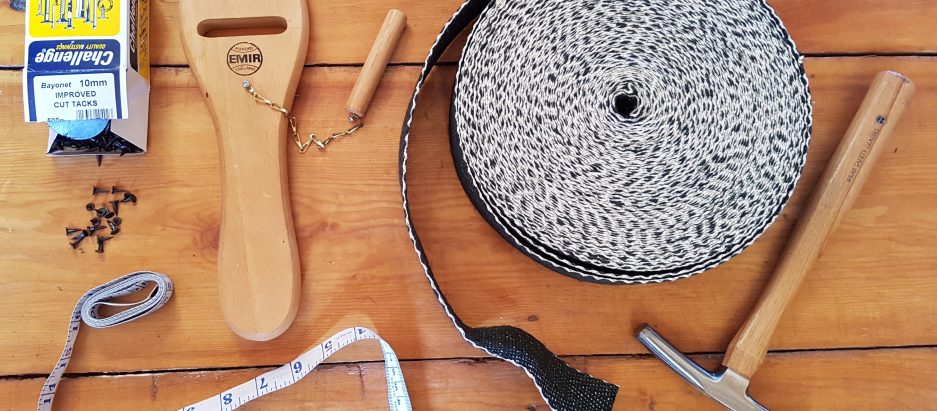When I was at Kempton, I had my eye out for a duet or piano stool to use as a wedding gift for a friend getting married this summer. I was really pleased with the one I found as the upholstery was minimal but the stool was in really good condition.
I wanted to have a go at adding buttoning to this stool so the first thing I did was work out where I needed the holes in the wood to be. Because there is a solid piece of wood between the top two panels, I couldn’t have an all over pattern so I settled for a pair of symmetrical patterns instead. I used a measuring tape and chalk but a ruler would have made life easier! I googled typical diamond proportions but ended up going with one that fitted the proportions of the stool. The holes were spaced 4 inches apart horizontally, and then staggered two inches over for the next row, then back to the original position for the bottom row. I went into college armed with my drill for a quick double check I was on the right track before I started marking marks.
The stool was obviously relatively modern so I was happy to go down the foam route when it came to stuffing. I bought one and a half inch high density foam, which only cost around £5. I covered the top and sides of the foam in polyester wadding, cut to size and stitched together.

In the meantime, I took the lid off the stool, removed all hinges and brackets, sanded the wood and painted it. I used another couple of Farrow and Ball taster pots, this time in Worsted. I topped it off with a layer of Rustoleum furniture wax which leaves a lovely silky finish.
Once the lid was painted, it was time to upholster. I hadn’t learned how to button before but I had watched friends doing it in class. After placing a piece of calico over the foam on the lid, I used a long needle (not double ended) to push Barbour twine up through each hole starting in the middle. I then moved the needle slightly, and brought the twine back down through the hole. Not having a double ended needle made finding the hole again difficult. Once I had finished, moving horizontally on the middle row and then the two outer rows, I was pretty unhappy with it. The pleats weren’t very defined and it just didn’t look good.
I mentioned this is class the following week and was told that I maybe hadn’t tied the string tight enough. I had secured it by tying it on to little rolls of webbing cut offs and I though I’d done a pretty good job. It turned out that the problem was I hadn’t made any holes in the foam. Back home, I undid all of the string and started again.
I bought a drill bit designed for making large circular holes in wood and tried it in the foam. In retrospect, an apple corer would have done a neater job but I got it done. With the first piece of twine I could already see the difference. It pulled the calico much deeper into the foam and created a lovely pleat. I also used a different pattern in terms of the order of the holes which you can see below.
I then tacked the calico around the foam, trying to keep the spacing as straight and as even as possible. I trimmed it down and then repeated the process with the top fabric. With the pleats, I had the fold facing into each complete diamond. The whole thing would have been a lot easier had I tracked down a double ended or buttoning needle! I edged the whole lot with some pretty pink braiding I picked up in my local haberdashery.
I went into college to make the buttons. I used the same top fabric, and made a mixture of plain and patterned buttons from my offcuts. I would highly recommend either using proper, heavy duty button making materials or sending off your fabric and having them made for you, it doesn’t cost very much. Once I had my 20 buttons, I played around with their positions until I was happy with it. I then attached them using the double ended needle my tutor had given me in pity the previous week.

Next for the underside of the lid. Because there was a solid piece of wood running through the middle, I wanted to lightly pad the interior so it couldn’t be felt. I re-tied all of the twine and then trimmed it down. I stuffed some spare cotton felt in and around the webbing sausages, followed by a layer of polyester wadding off cuts on each side. Finally I laid a single sheet of polyester wadding across the whole back, then covered it in calico and top fabric. I then trimmed the lot with a Stanley knife and covered the tacks with more of the same braiding.
My last job was to reattach the lid. I almost ruined the whole thing when I had the middle screw of the first hinge in when the whole thing toppled over and the screw was ripped out. Luckily the thread on the other two screws for that hinge was fine so I was able to get the rest in without incident. I’m really pleased with the outcome of this project as it was the first one I had done almost entirely at home on my own. I hope my friend will be happy with her wedding present!





















